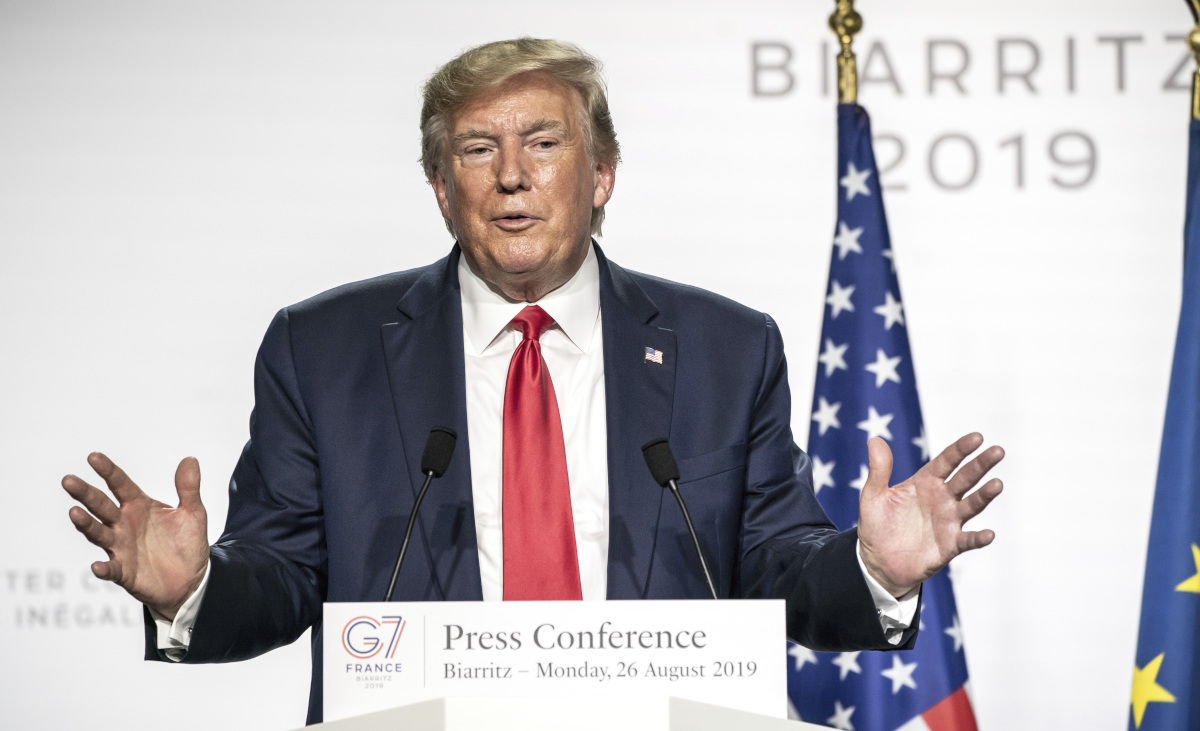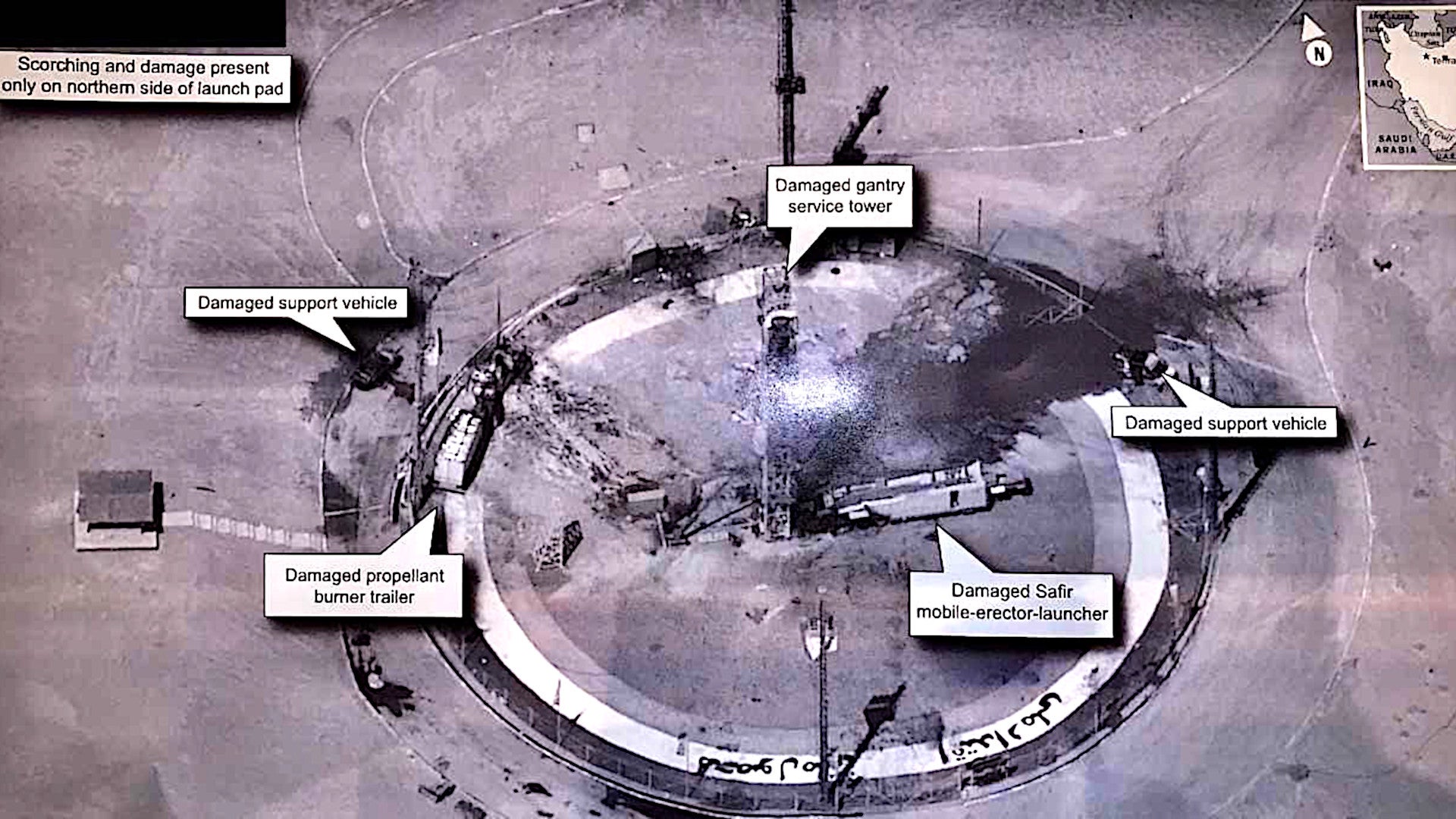U.S. President Donald Trump appears to have taken the highly unusual step of releasing an official and relatively high resolution annotated U.S. intelligence image of the recent failed space launch at Iran’s Imam Khomeini Space Center via Twitter and confirmed that it involved a Safir space launch vehicle. Trump also declared that the United States had no hand in the accident and offered Iran “best wishes” and “good luck.” It’s unclear if the President, who recently reiterated his willingness to meet with Iranian officials to try to de-escalate growing tensions, meant that to be an insult.
Trump sent out the Tweet with the message and attached image on Aug. 30, 2019. A black box at the upper left-hand corner appears to be a redaction of a previous classification marking. The social media post also indicates that the U.S. Intelligence Community refers to this particular launch pad as “Semnan Launch Site One.” This method of disclosure is unprecedented, but The War Zone, among others, has long reported that Trump routinely appears to send out missives on social media after receiving briefings, including those involving sensitive intelligence and military matters. Reports first emerged about the accident on Aug. 29, 2019, and Iran has since confirmed that it occurred.
“The United States of America was not involved in the catastrophic accident during final launch preparations for the Safir SLV [space launch vehicle] Launch at Semnan Launch Site One in Iran,” Trump wrote in his Tweet. “I wish Iran best wishes and good luck in determining what happened at Site One.”
The image shows extensive damage to the gantry, transporter-erector-launcher vehicle, and various other supporting vehicles, equipment, on and around the launch pad. The exact source of the imagery is unclear.
Its resolution is significantly higher than is typically found on commercial satellite images. It could be from a U.S. intelligence satellite. The low angle of the shot also raises the possibility that an unmanned aircraft took the picture. The U.S. has used stealthy RQ-170 Sentinel drones in the past to spy on sites inside Iran.
There is a visible flash reflected in the image and you can see hands, arms, the outline of a phone, all indicating that this is a picture of a physical photograph. It is very possible, if not probable, that Trump took the picture with his cell phone and posted it online. This could also account for what appears to be a slight bend in the image at the edges, though this could also indicate a panoramic image stitched together from multiple pictures. Those visible lines may also be from the printer.
Regardless, it is definitely distinct from the images that a satellite belonging commercial imagery firm Planet Labs took of the site on Aug. 29, 2019, which subsequently became public via the Middlebury Institute of International Studies at Monterey that same day. Maxar, another commercial imagery company, also released additional imagery. Those pictures were the first indications that something had gone wrong with Iran’s latest attempted Safir launch.
“This look likes the space launch vehicle blew up on the launch pad,” Dave Schmerler, a senior research associate at the Middlebury Institute, told NPR after sharing the images with them. “This failure happened maybe a couple of minutes before the image was taken.”
“It was due to some technical issues and it exploded,” an unnamed Iranian official told Reuters. “Our young scientists are working to fix the problem.”
Reuters said he offered no additional details about the incident. It’s unclear what the payload on top of the rocket might have been, but earlier in August, Iran had indicated that the Nahid-1 communications satellite was ready for launch. It seems all but certain that the accident destroyed whatever payload or payloads were present.
In January 2019, Iran made another rare acknowledgment of a failed satellite launch at Imam Khomeini Space Center. It remains unclear what happened, but Iran did release video of a newer Simorgh space launch vehicle blasting off successfully from the center. The Payam-e Amirkabir satellite, which Iran had officially said was an earth observation type for scientific research, however, never reached orbit.

Trump’s statement that the United States was not involved in this latest accident comes amid reports and rumors that the U.S. government had been launching covert operations to sabotage Iran’s ballistic missile development programs and other related work. Just recently, The New York Times reported that an unrelated American cyberattack in June 2019 had severely hampered Iran’s ability to monitor maritime activities in the Strait of Hormuz and plot attacks on or attempts to seize foreign ships. This did not prevent Iran’s Islamic Revolutionary Guard Corps (IRGC) from taking control of the British flagged tanker Stena Impero, along with two other ships, between July and August.
Of course, even without Trump’s Tweet, there is no other hard evidence that U.S. had any involvement in the Safir’s apparent explosion. Iran has conducted eight launches using this rocket, at least three of which are known to have failed.
The President’s offer of “best wishes” to Iran is curious given that the U.S. government’s position, as well as that of some of its allies, especially Israel, is that the Iranians are using their nascent space program as a cover for long-range ballistic missile developments, including the possible development of an intercontinental ballistic missile (ICBM). As such, the United States routinely criticizes space launches just as it does any other Iranian missile test.
With this in mind, it is certainly possible that Trump meant his condolences as a backhanded insult. The President is certainly not above disparaging opponents, both foreign and domestic, on Twitter and in public, as well as outright threatening them, too.
At the same time, this does also follow Trump’s latest public offer to meet with Iran’s President Hassan Rouhani on Aug. 26, 2019, at the G7 summit in France. The President has proposed such meetings in the past, as well.
“I have a good feeling. I think he [Rouhani] is going to want to meet and get their situation straightened out. They are hurting badly,” Trump told reporters. “They can’t do what they were saying they were going to do because if they do that, they will be met with really very violent force. So I think they are going to be good.”

Since May, the U.S. government had continued to warn about the potential for attack from Iran or its regional proxies against its interests or those of its allies. Iran did shoot down a U.S. Navy RQ-4A drone in June, which almost touched off retaliatory strikes. There have been a number of attacks on tankers in the Middle with links to Iran, as well as the aforementioned IRGC seizures of the Stena Impero and other ships.
Iranian-backed Houthi rebels in Yemen have notably stepped up attacks against Saudi Arabia, as well. There are also growing indications that Israel has increased its own campaign against Iran and its proxies through the Middle East, reportedly expanding strikes into Iraq and launching renewed operations in Lebanon.
Still, there have been hopes that things may finally be trending in the opposite direction. A U.S.-backed maritime security mission in the tense Strait of Hormuz, so far, appears to have deterred further Iranian attempts to seize any ships.
“I’m not sure I’m ready to call the crisis over yet, but so far so good,” U.S. Secretary of Defense Mark Esper told reporters at the Pentagon on Aug. 28, 2019. “We hope the trend lines continue that way. And we hope that the parties, that the Iranians would agree to talk – meet and talk and help us resolve these issues.”
So far, Iran has refused to meet with the United States until it rolls back sanctions and has also called on the U.S. government to respect the terms of a controversial deal of its nuclear program, which the Trump Administration
withdrew from in 2018. Whether Trump’s Tweet over the Safir accident helps lead to any new movement on the diplomatic front remains to be seen.
Contact the author: joe@thedrive.com
